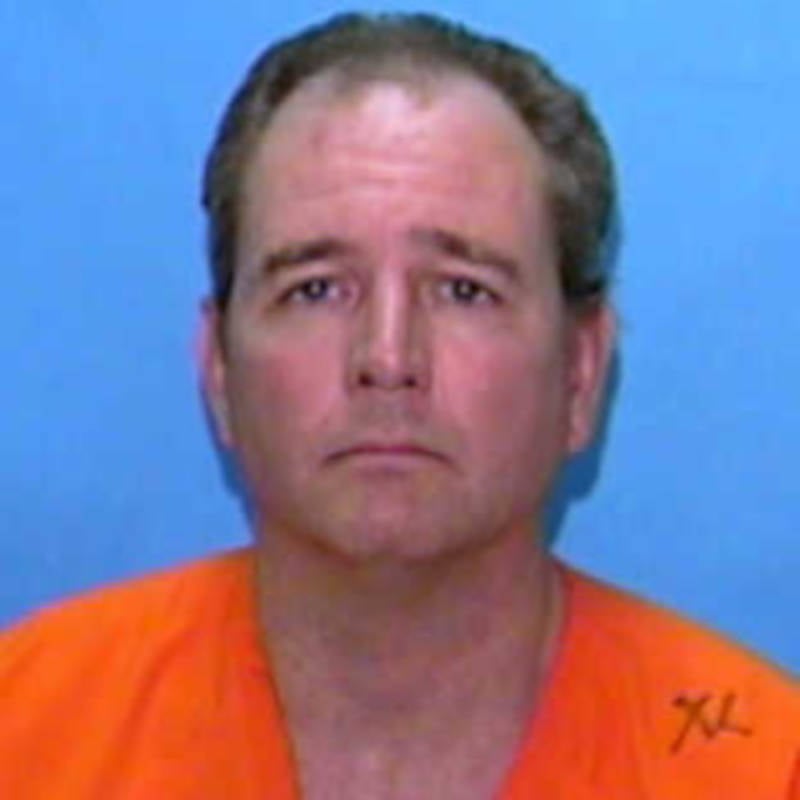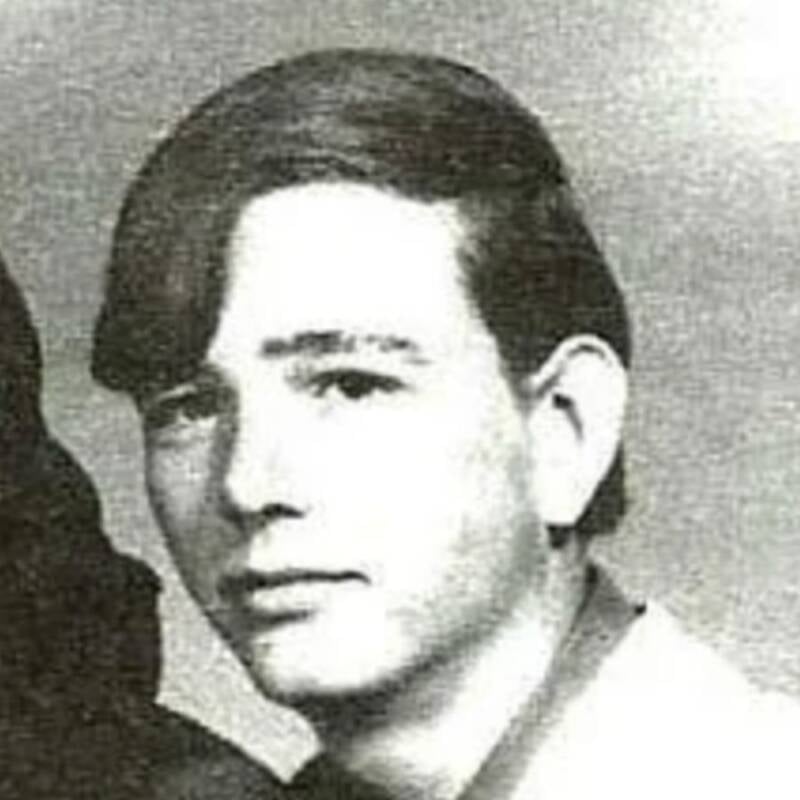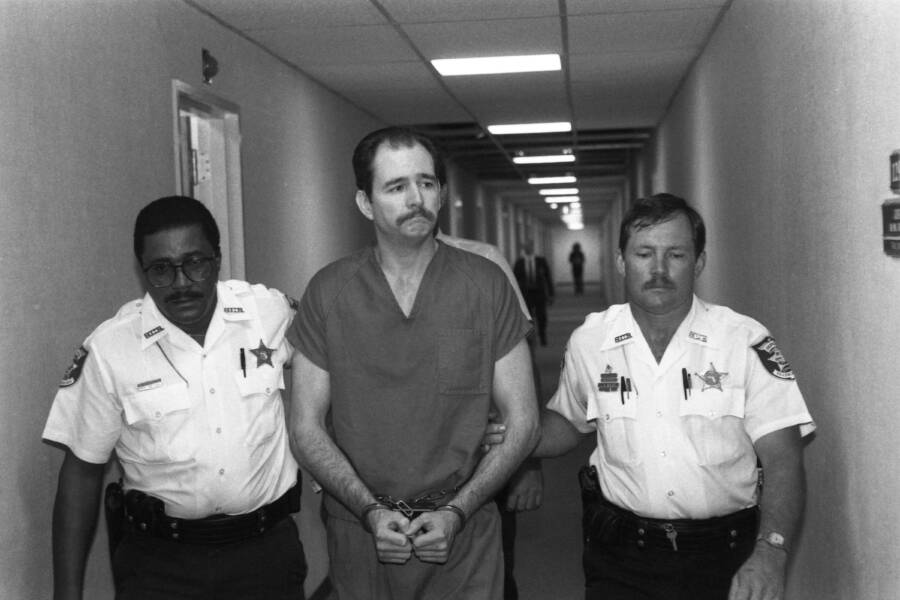Over four nights in August 1990, Danny Rolling viciously murdered five college students in Gainesville, Florida — and after he was caught, police discovered these weren't his first killings.
In August 1990, five college students in Gainesville, Florida, were horrifically murdered in their apartments. Despite an extensive investigation, the police couldn’t figure out who was behind the vicious crimes. Then, that November, a woman called Crime Stoppers to put forth the name of a suspect: Danny Rolling.

Public DomainDanny Rolling killed eight people between 1989 and 1990.
It turned out that Rolling had been arrested for a robbery not far from Gainesville less than two weeks after the murders and was still behind bars. And when the police tracked him down, they discovered that his DNA matched samples found at the crime scenes. They’d found the Gainesville Ripper — but the grisly spree wasn’t the first time Rolling had killed.
Investigators soon discovered that Rolling had fatally stabbed a Louisiana man along with his daughter and eight-year-old grandson back in November 1989. He’d also shot his own father, though the elder Rolling had survived. Danny Rolling reportedly claimed that he wanted to be a “superstar” like Ted Bundy.
Rolling was executed in 2006, but his chilling legacy endures to this day. Even those who don’t recognize his name will certainly know of the horror movie his crimes inspired: the cult classic 1996 film Scream.
This is the disturbing tale of Danny Rolling and the true story behind Scream.
Danny Rolling’s Troubled Early Life
Danny Rolling was born in Shreveport, Louisiana, in 1954, and he faced abuse from his earliest days. His father, a war veteran and a police officer, frequently beat him and told him that he wished he’d never been born.
Rolling’s mother, Claudia, tried to escape the toxic marriage, but time and again she returned. By the time Danny was in third grade, his counselors had diagnosed him with aggressive tendencies and poor impulse control.
As a teenager, Rolling started peeping into girls’ windows to see them naked, which eventually “became a compulsion,” psychologist Dr. Harry Krop testified at a 1994 hearing, as reported by the Tampa Bay Times at the time. He also began drinking, and he was arrested at least twice because of it. Ultimately, Danny Rolling dropped out of high school and enlisted in the U.S. Air Force.

RedditA young Danny Rolling, who would later go on to become known as the Gainesville Ripper.
His stint in the military lasted just a year, as he faced trouble for drug possession and disobeying orders. He was honorably discharged, returned to Shreveport, and married a woman he met at church. His first child was born a few months later, soon after he turned 21, and he dealt with the pressures of marriage and fatherhood by drinking, smoking marijuana, and peeping into windows again.
Then, his crimes began to escalate. Over the next few years, Danny Rolling robbed two Winn-Dixie supermarkets and several other stores. He spent most of his 20s in prison for armed robbery. He was released in 1984, but he was stealing again within a year — and this time, his misdeeds didn’t stop there.
The Rise Of The Gainesville Ripper
In November 1989, three bodies were found in a Shreveport home: Tom Grissom, his daughter Julie, and his eight-year-old grandson Sean. Julie’s corpse was arranged in a provocative pose. The murder went unsolved, and for a while, it seemed as if the perpetrator would get away with the disturbing crime. Then, a spree of eerily similar killings broke out in Florida.
The Gainesville Ripper first struck in the early morning hours of August 24, 1990. He broke into the apartment of two incoming freshmen at the University of Florida, Sonja Larson and Christina Powell. Danny Rolling bound and gagged the girls before raping them, stabbing them to death, and posing their bodies.
The following night, August 25, Rolling entered the apartment of 18-year-old Christa Hoyt, a student at Santa Fe College in Gainesville. She wasn’t home, so he hid out until he heard her return and then sneaked up behind her, put her in a choke hold, taped her mouth, and tied her up. Rolling then raped her and stabbed her, but this time, he sliced her abdomen open when he was done.
After leaving Hoyt’s apartment, Rolling realized he couldn’t find his wallet. Fearing he’d left it inside, he went back — and while he was there, he cut off Hoyt’s head and placed it on a shelf staring at her body, which was posed on her bed just like the corpses of his previous victims.

WillMcC/Wikimedia CommonsA memorial to the victims of the Gainesville Ripper near the University of Florida campus.
By this point, news of the murders had spread across Gainesville. Authorities put out as much information as they could to try to catch the suspect, and students at the city’s universities slept in groups and took every precaution they could think of to secure their dorms and apartments. Despite this, the Gainesville Ripper struck again on August 27.
That night, Rolling murdered Tracey Paules and Manuel Taboada, both 23-year-old University of Florida students. He attacked Taboada while he slept, and when Paules heard the struggle and came to investigate, Rolling chased her to her bedroom. Paules tried to barricade herself inside, but the serial killer managed to break down her door, rape her, stab her to death, and pose her corpse.
At the time, nobody knew that the murders of Paules and Taboada would be the Gainesville Ripper’s last. The University of Florida canceled classes, people carried baseball bats around with them, and nobody went out alone during the day or night. Students even started sleeping in shifts so that someone was awake at all times. By the end of August, many students had left campus, and some of them never returned because they feared for their lives.
Despite having four separate crime scenes to gather evidence from, the police couldn’t name a suspect. Danny Rolling had covered his tracks carefully, disposing of anything that he could have left fingerprints on. And while he did leave semen behind, investigators had nothing to test it against.
At least, not until a woman from Shreveport called Crime Stoppers three months later.
How A Single Tip Led The Police To Danny Rolling
Cindy Juracich had heard about the Gainesville murders on the radio while driving through Florida that August. The crimes brought to mind a man Juracich had previously attended church with in Shreveport: Danny Rolling.
Rolling had frequently visited the home of Juracich and her husband, Steven Dobbin, outside of church. “He’d come over every night for a while,” Juracich told ABC News in 2022, “and then one night, Steven came in and goes, ‘He’s got to go.'”
Her husband then told her that Rolling had admitted that he “likes to stick knives into people.”
Juracich hadn’t seen Rolling since he’d left Shreveport, but she had a horrible gut feeling that he had something to do with the murders in Gainesville. In November 1990, she decided to call Crime Stoppers just to put his name forward. By this time, investigators had started to make connections between the Gainesville killings and the triple homicide in Shreveport a year prior.

Mike Pease/Tampa Bay Times via ZUMA Wire / Alamy Stock PhotoDanny Rolling after his competency hearing in July 1991.
Detectives looked into Rolling and discovered that he’d been arrested on Sept. 7, 1990, for robbing a supermarket in Ocala, Florida, about 40 miles south of Gainesville. Thankfully, he was still in jail, and a quick blood test revealed that he had the same blood type as the suspect in both Shreveport and Gainesville.
Danny Rolling was charged with five counts of murder, and just as his trial began in 1994, he pleaded guilty. He was sentenced to death and died by lethal injection on Oct. 25, 2006.
His chilling legacy didn’t end there, though.
The True Story Behind Scream
When the news of the Gainesville Ripper broke in late 1990, Kevin Williamson was preparing to move to Los Angeles to take screenwriting classes at UCLA. The case inspired Williamson, and he started looking deeper into it as Rolling’s trial approached.
“Back when I was researching Danny Rolling,” Williamson told Entertainment Tonight in 2013, “I wanted to write about a serial killer on a college campus.”

Dimension FilmsDanny Rolling and his vicious murders as the Gainesville Ripper served as the true story behind Scream that inspired screenwriter Kevin Williamson.
He took elements of Rolling’s story and put them into one of his screenplays: a movie called Scream.
The film released in 1996 and soon became a cult classic. Williamson’s career skyrocketed, and he went on to write for the hit series Dawson’s Creek, the horror movie I Know What You Did Last Summer, and a couple of the sequels to Scream — one of which indeed takes place on a college campus.
As such, Danny Rolling’s vicious crimes live on, not just through the grief of his victims’ loved ones but as the true story behind Scream, one of modern history’s most successful slasher film franchises.
After reading about Danny Rolling and the true story behind Scream, go inside 12 other true stories that inspired horror films. Then, discover the stories behind some of Hollywood’s most famous serial killer movies.





